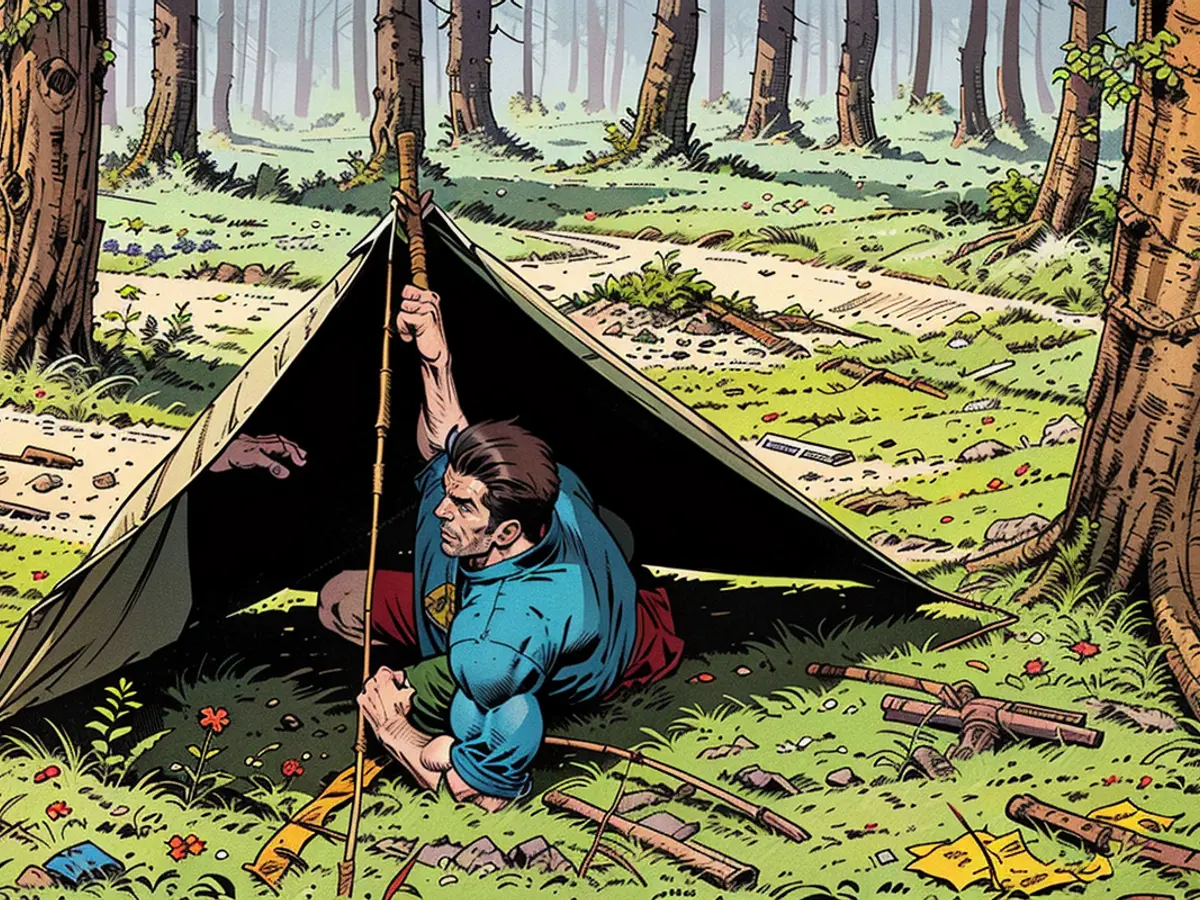The enjoyable allure of bushcraft
Venturing into the untamed wilderness for some wilderness crafting can significantly benefit individuals, allowing them to delve into primitive craftsmanship reminiscent of the Stone Age. Two authorities, one from the field and the other from academia, explain why this is the case.
Escaping the pressures of a demanding job or the cacophony of city life is not exactly a novelty. Furthermore, the practice of immersing oneself in nature for relaxation is now commonly known as "forest bathing." Additionally, there have been numerous accounts of individuals embarking on survival trips, especially since television shows like "Alone" have gained traction. However, bushcrafting encompasses more than just these aspects.
Bushcrafting entails a balance between opposites: simplicity and a clear objective. It's not about fighting for survival, but rather about harmonizing with nature and creating something with your own hands, utilizing primitive methods. Individuals venturing into the wilderness through bushcrafting do so with the purpose of surviving using ancient techniques, not out of necessity, but as a means of stress relief.
What is bushcrafting?
The term "bushcrafting" is derived from the words "bush" (wilderness) and "craft" (handiwork). While there are indeed similarities with "survival," asserts bushcraft expert Sepp Fischer to ntv.de, the key distinction lies in their purposes. Unlike survival, bushcrafting is not centered around surviving a struggle, but rather a voluntary commitment to living "off the beaten path." The techniques involved can be categorized into three areas: Stone Age methods, expedition knowledge, and camping. By blending ancient wisdom with modern technology, bushcrafters can improvise any necessary equipment, explains Fischer. In his guided forest adventures, he teaches techniques for:
- Constructing shelter
- Collecting and purifying water
- Creating fire
- Identifying edible plants and animals
- Signaling for help
- Navigating utilizing natural landmarks
- Crafting containers and tools
Getting involved is as easy as carrying a pocket knife, says Fischer. "If someone is eager to join, they're welcome."
What do you need for bushcrafting?
While the allure of venturing into the wilderness with minimal gear may be appealing, Fischer cautions against this for beginners. He suggests: "Either I know what I'm doing, or I'll endure the consequences." In his bushcrafting courses in Bavaria, he emphasizes the importance of teaching old handcraft skills like whittling and ancient fire-making techniques in a casual setting. For this, he advises beginners to bring at least a sleeping bag and a "tarp." This waterproof sheet offers protection from rain, sun, or wind while outdoors. Fischer himself is well-prepared, aiming to enjoy his time in nature as stress-free as possible. "If I don't bring anything, I'm just being silly," he says to those who criticize his preparations.
A knife, sleeping bag, and tarp are sufficient to get beginners started, according to Fischer. He also considers a rope essential. It can be utilized to secure the tarp or hang it while transporting something. Even a broken limb can be immobilized with it - skills that aspiring bushcrafters can learn in his wilderness first aid courses.
Priorities in bushcrafting - what's most important?
Once you have gathered your gear and found a suitable location, the question is: what should you focus on first in the wilderness? It's not drinkable water, says Fischer. "Meanwhile, you could be caught in a storm or cold." First, you must locate a suitable spot for your camp. As Fischer explains in his "Book of Forest Craftsmanship," the correct sequence in bushcrafting, like in survival, is:
- Camp
- Fire
- Water
- Food
And here, there are indeed similarities with camping, as Fischer points out: "You set up your tent, then you light the gas stove, prepare some sausages."
Why Bushcrafting is So Revitalizing
Fischer's own journey into Bushcrafting began after enduring a period of excessive stress. "An extremely demanding job," recounts Fischer, led him to his breaking point. At the time, he had not spent time in nature for nine years. "Nature-starved," as he describes himself. Upon concocting his first spruce needle tea, he discovers the restorative power of nature. He becomes increasingly connected to life "within," "from," and "in" nature. For the past decade, he has solely earned a living from his outdoor courses.
Why is Bushcrafting so rejuvenating? "You're sufficiently occupied with finding a warm place to sleep," says Fischer. And the hands-on work in the present moment diverts attention from dwelling on negative thoughts. Additionally, taking better care of oneself in the wilderness bolsters self-confidence over time.
The Forest's Impact on Various Levels
Professor Daniela Haluza discusses the forest's effects on us with ntv.de. She is an environmental physician and public health expert at the Center for Public Health of the Medical University of Vienna. Her department for environmental hygiene and environmental medicine has demonstrated that spending time in the forest possesses "profoundly positive effects on human well-being." Studies have also shown a stress-relieving impact: participants experienced significantly lower cortisol levels (cortisol = "stress hormone") after spending time in the forest. A decrease in heart rate and stable blood pressure were also observed, indicating an overall soothing effect of nature.
How Colors, Sounds, and Scents Work in the Forest
When we are in the forest, we find the green calming and rejuvenating. This is not merely a subjective impression. "This color has a proven calming effect on the nervous system and can aid in reducing stress levels," says Haluza. If water - and thus the color blue - is also present, the effect is even more invigorating, according to Haluza. Water symbolizes life, carrying a special evolutionary significance.
Beyond colors, auditory cues like the crinkling of leaves, the babbling of a brook, or the tweeting of birds, contribute to relaxation. Ultimately, scents play a role in forest restoration: research demonstrates that the aroma of forest floors, moss, and coniferous trees has a soothing impact and stimulates the parasympathetic nervous system, which is associated with relaxation and healing.
Fischer is also convinced that the forest, particularly Bushcrafting, is restorative for stress. When his participants express exhaustion at night and can't recall their activities, he muses, "Bushcrafting would be the ideal antidote to burnout." Often, there's no mobile reception on his tours, which his participants enjoy. Instantly, they become more relaxed. As Fischer asserts, it's impossible to rush around stressed while Bushcrafting.
The Satisfaction of Handcrafting - Why is it so Invigorating?
It's not just the verdure, the serenity that improves the state of mind of stressed individuals. As Haluza elucidates, manual activities "have been scientifically proven to have a positive psychological impact." Especially crafting objects (but also gardening) proves to be remarkable. Mindfulness and the complete engagement in the present moment contribute to this. "This state, known as 'flow', is characterized by total absorption in the task and results in heightened satisfaction and reduced stress," explains Haluza. Such "tactile" activities provide a calming link to our origins and ground us. They also instill a sense of accomplishment.
Those eager to begin don't have to dive headfirst. Overnighting and fire-making are only permitted in designated locations. However, as Fischer suggests, "I only need a tree to start. I could practice Bushcrafting on a traffic island." And it seems that there's an abundance of undiscovered gems waiting to be explored by us - in peace and tranquility.
After immersing oneself in the serene environment of the forest, the relaxative effects of nature can be amplified through practice of handcrafts, such as creating a shelter or fashioning a tool.
The revitalizing effects of bushcrafting, including forest bathing, stem from the allure of ancient methods and the satisfaction derived from handcrafting, connecting individuals back to their roots and instilling a sense of accomplishment.







